climax英语修辞学 层进法
- 格式:ppt
- 大小:68.50 KB
- 文档页数:6

英语中有19种修辞手法,它们分别是:Simile明喻、Metaphor 隐喻,暗喻、Metonymy 借喻,转喻、Synecdoche 提喻、Synaesthesia 通感,联觉,移觉、Personification 拟人、Hyperbole 夸张、Parallelism 排比, 平行、Euphemism 委婉,婉辞法、Allegory 讽喻,比方、Irony 反语、Pun 双关、Parody 仿拟、Rhetorical question 修辞疑问、Antithesis 对照,对比,对偶、Paradox 隽语、Oxymoron 反意法,逆喻、Climax 渐进法,层进法、Anticlimax 渐降法。
1.Simile 明喻明喻是将具有共性的不同事物作对比.这种共性存在于人们的心里,而不是事物的自然属性.标志词常用like, as, seem, as if, as though, similar to, such as等.例如:1>.He was like a cock who thought the sun had risen to hear him crow.2>.I wandered lonely as a cloud.3>.Einstein only had a blanket on, as if he had just walked out of a fairy tale.2.Metaphor 隐喻,暗喻隐喻是简缩了的明喻,是将某一事物的名称用于另一事物,通过比较形成.例如:1>.Hope is a good breakfast, but it is a bad supper.2>.Some books are to be tasted, others swallowed, and some few to be chewed and digested.3.Metonymy 借喻,转喻借喻不直接说出所要说的事物,而使用另一个与之相关的事物名称.I.以容器代替内容,例如:1>.The kettle boils. 水开了.2>.The room sat silent. 全屋人安静地坐着.II.以资料.工具代替事物的名称,例如:Lend me your ears, please. 请听我说.III.以作者代替作品,例如:a complete Shakespeare 莎士比亚全集VI.以具体事物代替抽象概念,例如:I had the muscle, and they made money out of it. 我有力气,他们就用我的力气赚钱.4.Synecdoche 提喻提喻用部分代替全体,或用全体代替部分,或特殊代替一般.例如:1>.There are about 100 hands working in his factory.(部分代整体)他的厂里约有100名工人.2>.He is the Newton of this century.(特殊代一般)他是本世纪的牛顿.3>.The fox goes very well with your cap.(整体代部分)这狐皮围脖与你的帽子很相配.5.Synaesthesia 通感,联觉,移觉这种修辞法是以视.听.触.嗅.味等感觉直接描写事物.通感就是把不同感官的感觉沟通起来,借联想引起感觉转移,“以感觉写感觉”。
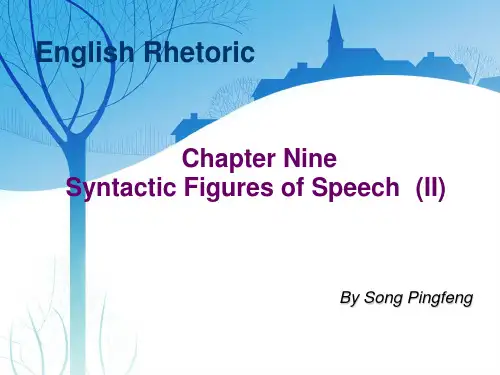
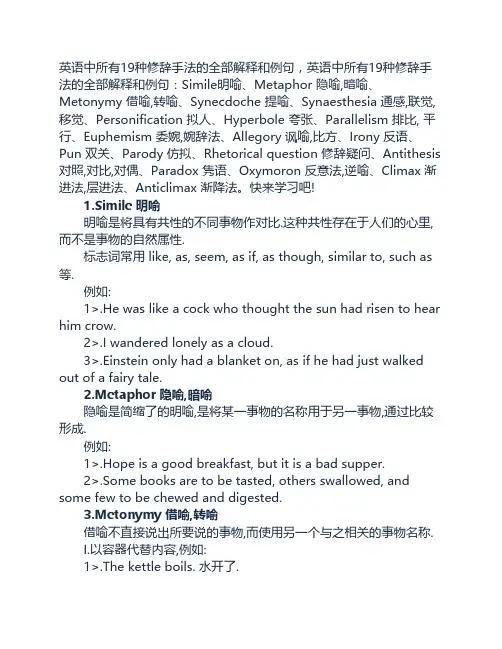
英语中所有19种修辞手法的全部解释和例句,英语中所有19种修辞手法的全部解释和例句:Simile明喻、Metaphor 隐喻,暗喻、Metonymy 借喻,转喻、Synecdoche 提喻、Synaesthesia 通感,联觉,移觉、Personification 拟人、Hyperbole 夸张、Parallelism 排比, 平行、Euphemism 委婉,婉辞法、Allegory 讽喻,比方、Irony 反语、Pun 双关、Parody 仿拟、Rhetorical question 修辞疑问、Antithesis 对照,对比,对偶、Paradox 隽语、Oxymoron 反意法,逆喻、Climax 渐进法,层进法、Anticlimax 渐降法。
快来学习吧! 1.Simile 明喻 明喻是将具有共性的不同事物作对比.这种共性存在于人们的心里,而不是事物的自然属性. 标志词常用 like, as, seem, as if, as though, similar to, such as 等. 例如: 1>.He was like a cock who thought the sun had risen to hear him crow. 2>.I wandered lonely as a cloud. 3>.Einstein only had a blanket on, as if he had just walked out of a fairy tale. 2.Metaphor 隐喻,暗喻 隐喻是简缩了的明喻,是将某一事物的名称用于另一事物,通过比较形成. 例如: 1>.Hope is a good breakfast, but it is a bad supper. 2>.Some books are to be tasted, others swallowed, and some few to be chewed and digested. 3.Metonymy 借喻,转喻 借喻不直接说出所要说的事物,而使用另一个与之相关的事物名称. I.以容器代替内容,例如: 1>.The kettle boils. 水开了. 2>.The room sat silent. 全屋人安静地坐着. II.以资料.工具代替事物的名称,例如: Lend me your ears, please. 请听我说. III.以作者代替作品,例如: a complete Shakespeare 莎士比亚全集 VI.以具体事物代替抽象概念,例如: I had the muscle, and they made money out of it. 我有力气,他们就用我的力气赚钱. 4.Synecdoche 提喻 提喻用部分代替全体,或用全体代替部分,或特殊代替一般. 例如: 1>.There are about 100 hands working in his factory.(部分代整体) 他的厂里约有100名工人. 2>.He is the Newton of this century.(特殊代一般) 他是本世纪的牛顿. 3>.The fox goes very well with your cap.(整体代部分) 这狐皮围脖与你的帽子很相配. 5.Synaesthesia 通感,联觉,移觉 这种修辞法是以视.听.触.嗅.味等感觉直接描写事物.通感就是把不同感官的感觉沟通起来,借联想引起感觉转移,“以感觉写感觉”。
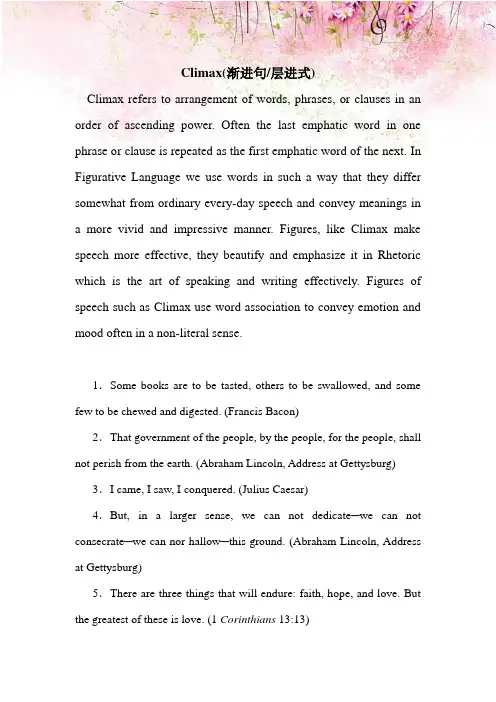
Climax(渐进句/层进式)Climax refers to arrangement of words, phrases, or clauses in an order of ascending power. Often the last emphatic word in one phrase or clause is repeated as the first emphatic word of the next. In Figurative Language we use words in such a way that they differ somewhat from ordinary every-day speech and convey meanings in a more vivid and impressive manner. Figures, like Climax make speech more effective, they beautify and emphasize it in Rhetoric which is the art of speaking and writing effectively. Figures of speech such as Climax use word association to convey emotion and mood often in a non-literal sense.1.Some books are to be tasted, others to be swallowed, and some few to be chewed and digested. (Francis Bacon)2.That government of the people, by the people, for the people, shall not perish from the earth. (Abraham Lincoln, Address at Gettysburg) 3.I came, I saw, I conquered. (Julius Caesar)4.But, in a larger sense, we can not dedicate─we can not consecrate─we can nor hallow─this ground. (Abraham Lincoln, Address at Gettysburg)5.There are three things that will endure: faith, hope, and love. But the greatest of these is love. (1 Corinthians 13:13)6.I think we've reached a point of great decision, not just for our nation, not only for all humanity, but for life upon the earth.(George Wald A Generation in Search of a Future, March 4, 1969)7."...Lost, vaded, broken, dead within an hour." (William Shakespeare, The Passionate Pilgrim, XIII)8.I like work: it fascinates me. I can sit and look at it for hours. I love to keep it by me: the idea of getting rid of it nearly breaks my heart.9.To strive, to seek, to find, and not to yield. (Alfred Tennyson, Ulysses)。
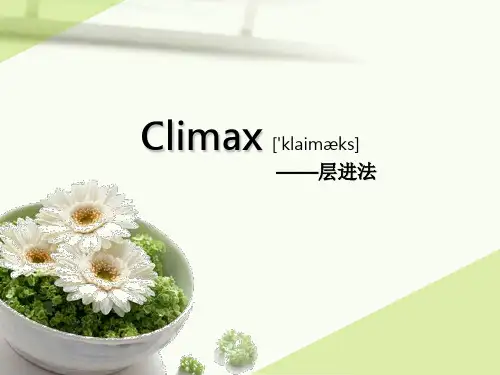
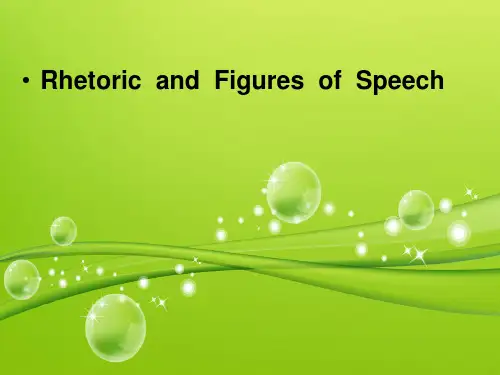
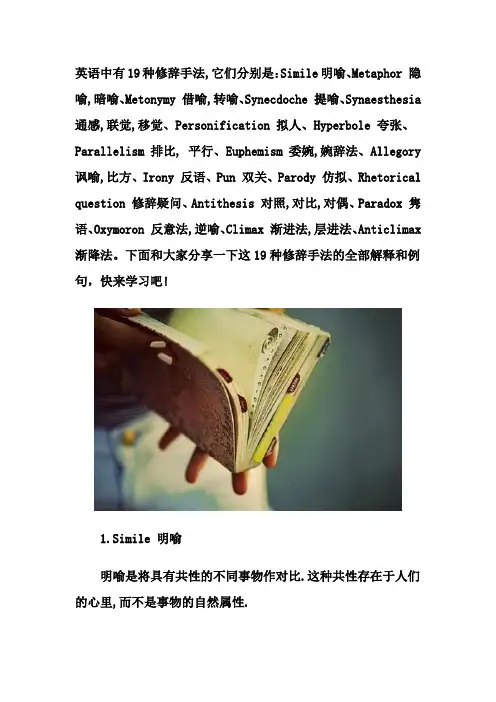
英语中有19种修辞手法,它们分别是:Simile明喻、Metaphor 隐喻,暗喻、Metonymy 借喻,转喻、Synecdoche 提喻、Synaesthesia 通感,联觉,移觉、Personification 拟人、Hyperbole 夸张、Parallelism 排比, 平行、Euphemism 委婉,婉辞法、Allegory 讽喻,比方、Irony 反语、Pun 双关、Parody 仿拟、Rhetorical question 修辞疑问、Antithesis 对照,对比,对偶、Paradox 隽语、Oxymoron 反意法,逆喻、Climax 渐进法,层进法、Anticlimax 渐降法。
下面和大家分享一下这19种修辞手法的全部解释和例句,快来学习吧!1.Simile 明喻明喻是将具有共性的不同事物作对比.这种共性存在于人们的心里,而不是事物的自然属性.标志词常用 like, as, seem, as if, as though, similar to, such as等.例如:1>.He was like a cock who thought the sun had risen to hear him crow.2>.I wandered lonely as a cloud.3>.Einstein only had a blanket on, as if he had just walked out of a fairy tale.2.Metaphor 隐喻,暗喻隐喻是简缩了的明喻,是将某一事物的名称用于另一事物,通过比较形成.例如:1>.Hope is a good breakfast, but it is a bad supper.2>.Some books are to be tasted, others swallowed, and some few to be chewed and digested.3.Metonymy 借喻,转喻借喻不直接说出所要说的事物,而使用另一个与之相关的事物名称.I.以容器代替内容,例如:1>.The kettle boils. 水开了.2>.The room sat silent. 全屋人安静地坐着.II.以资料.工具代替事物的名称,例如:Lend me your ears, please. 请听我说.III.以作者代替作品,例如:a complete Shakespeare 莎士比亚全集VI.以具体事物代替抽象概念,例如:I had the muscle, and they made money out of it. 我有力气,他们就用我的力气赚钱.4.Synecdoche 提喻提喻用部分代替全体,或用全体代替部分,或特殊代替一般.例如:1>.There are about 100 hands working in his factory.(部分代整体)他的厂里约有100名工人.2>.He is the Newton of this century.(特殊代一般)他是本世纪的牛顿.3>.The fox goes very well with your cap.(整体代部分)这狐皮围脖与你的帽子很相配.5.Synaesthesia 通感,联觉,移觉这种修辞法是以视.听.触.嗅.味等感觉直接描写事物.通感就是把不同感官的感觉沟通起来,借联想引起感觉转移,“以感觉写感觉”。
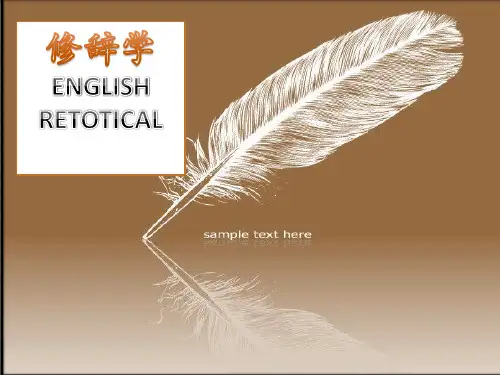

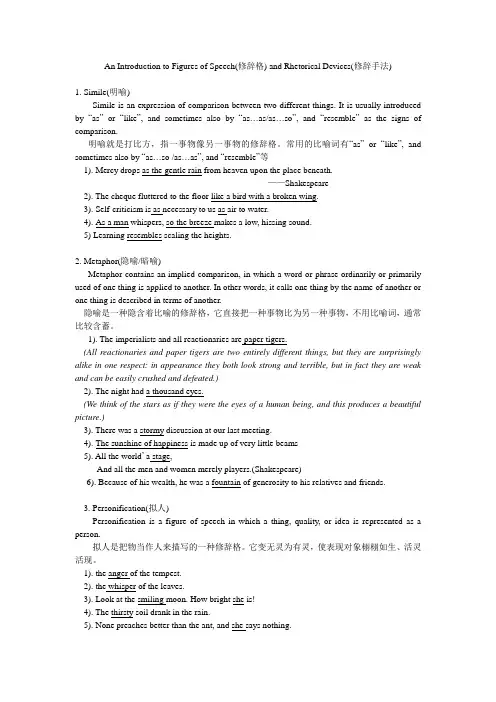
An Introduction to Figures of Speech(修辞格) and Rhetorical Devices(修辞手法)1. Simile(明喻)Simile is an expression of comparison between two different things. It is usually introduced by “as”or “like”, and sometimes also by “as…as/as…so”, and “resemble”as the signs of comparison.明喻就是打比方,指一事物像另一事物的修辞格。
常用的比喻词有“as”or “like”, and sometimes also by “as…so /as…as”, and “resemble”等1). Mercy drops as the gentle rain from heaven upon the place beneath.——Shakespeare2). The cheque fluttered to the floor like a bird with a broken wing.3). Self-criticism is as necessary to us as air to water.4). As a man whispers, so the breeze makes a low, hissing sound.5) Learning resembles scaling the heights.2. Metaphor(隐喻/暗喻)Metaphor contains an implied comparison, in which a word or phrase ordinarily or primarily used of one thing is applied to another. In other words, it calls one thing by the name of another or one thing is described in terms of another.隐喻是一种隐含着比喻的修辞格,它直接把一种事物比为另一种事物,不用比喻词,通常比较含蓄。

19种英语修辞手法简单介绍19种英语修辞手法简单介绍除了最常见的明喻、暗喻、拟人,英语中还有很多修辞手法。
有一些可能是你经常见到却没有意识到的。
下面是店铺带来的19种英语修辞手法简单介绍,希望对你有帮助。
英语中有19种修辞手法,它们分别是:Simile明喻、Metaphor 隐喻,暗喻、Metonymy 借喻,转喻、Synecdoche 提喻、Synaesthesia 通感,联觉,移觉、Personification 拟人、Hyperbole 夸张、Parallelism 排比,平行、Euphemism 委婉,婉辞法、Allegory 讽喻,比方、Irony 反语、Pun 双关、Parody 仿拟、Rhetorical question 修辞疑问、Antithesis 对照,对比,对偶、Paradox 隽语、Oxymoron 反意法,逆喻、Climax 渐进法,层进法、Anticlimax 渐降法。
下面和大家分享一下这19种修辞手法的全部解释和例句,快来学习吧!1.Simile 明喻明喻是将具有共性的不同事物作对比。
这种共性存在于人们的心里,而不是事物的自然属性。
标志词常用 like, as, seem, as if, as though, similar to, such as 等。
例如:1>.He was like a cock who thought the sun had risen to hear him crow。
2>.I wandered lonely as a cloud。
3>.Einstein only had a blanket on, as if he had just walked out of a fairy tale。
2.Metaphor 隐喻,暗喻隐喻是简缩了的明喻,是将某一事物的名称用于另一事物,通过比较形成。
例如:1.Hope is a good breakfast, but it is a bad supper。
2020考研英语:语法常见的修辞解析
考研英语有许多题目组成,方便大家及时了解,下面由出国留学网小编为你精心准备了“2020考研英语:语法常见的修辞解析”,持续关注本站将可以持续获取更多的考试资讯!
2020考研英语:语法常见的修辞解析
climax
渐进法,层进法
这种修辞是将一系列词语按照意念的大小、轻重、深浅、高低等逐层渐进,最后达到顶点。
功能:可以增强语势,逐渐加深读者印象。
例如:
1、 I am sorry, I am so sorry, I am so extremely sorry。
真的真的真的很抱歉
2、 Eye had not seen nor ear heard, and nothing had touched his heart of stone。
看不到、听不到,没有什么可以触碰到他那颗石头般的。
Climax(渐进句/层进式)Climax refers to arrangement of words, phrases, or clauses in an order of ascending power. Often the last emphatic word in one phrase or clause is repeated as the first emphatic word of the next. In Figurative Language we use words in such a way that they differ somewhat from ordinary every-day speech and convey meanings in a more vivid and impressive manner. Figures, like Climax make speech more effective, they beautify and emphasize it in Rhetoric which is the art of speaking and writing effectively. Figures of speech such as Climax use word association to convey emotion and mood often in a non-literal sense.1.Some books are to be tasted, others to be swallowed, and some few to be chewed and digested. (Francis Bacon)2.That government of the people, by the people, for the people, shall not perish from the earth. (Abraham Lincoln, Address at Gettysburg) 3.I came, I saw, I conquered. (Julius Caesar)4.But, in a larger sense, we can not dedicate─we can not consecrate─we can nor hallow─this ground. (Abraham Lincoln, Address at Gettysburg)5.There are three things that will endure: faith, hope, and love. But the greatest of these is love. (1 Corinthians 13:13)6.I think we've reached a point of great decision, not just for our nation, not only for all humanity, but for life upon the earth.(George Wald A Generation in Search of a Future, March 4, 1969)7."...Lost, vaded, broken, dead within an hour." (William Shakespeare, The Passionate Pilgrim, XIII)8.I like work: it fascinates me. I can sit and look at it for hours. I love to keep it by me: the idea of getting rid of it nearly breaks my heart.9.To strive, to seek, to find, and not to yield. (Alfred Tennyson, Ulysses)。
Climax(渐进句/层进式)Climax refers to arrangement of words, phrases, or clauses in an order of ascending power. Often the last emphatic word in one phrase or clause is repeated as the first emphatic word of the next. In Figurative Language we use words in such a way that they differ somewhat from ordinary every-day speech and convey meanings in a more vivid and impressive manner. Figures, like Climax make speech more effective, they beautify and emphasize it in Rhetoric which is the art of speaking and writing effectively. Figures of speech such as Climax use word association to convey emotion and mood often in a non-literal sense.1.Some books are to be tasted, others to be swallowed, and some few to be chewed and digested. (Francis Bacon)2.That government of the people, by the people, for the people, shall not perish from the earth. (Abraham Lincoln, Address at Gettysburg) 3.I came, I saw, I conquered. (Julius Caesar)4.But, in a larger sense, we can not dedicate─we can not consecrate─we can nor hallow─this ground. (Abraham Lincoln, Address at Gettysburg)5.There are three things that will endure: faith, hope, and love. But the greatest of these is love. (1 Corinthians 13:13)6.I think we've reached a point of great decision, not just for our nation, not only for all humanity, but for life upon the earth.(George Wald A Generation in Search of a Future, March 4, 1969)7."...Lost, vaded, broken, dead within an hour." (William Shakespeare, The Passionate Pilgrim, XIII)8.I like work: it fascinates me. I can sit and look at it for hours. I love to keep it by me: the idea of getting rid of it nearly breaks my heart.9.To strive, to seek, to find, and not to yield. (Alfred Tennyson, Ulysses)。